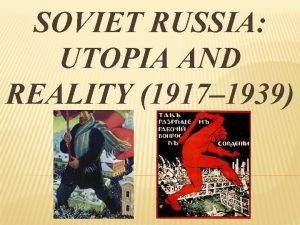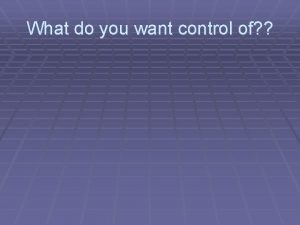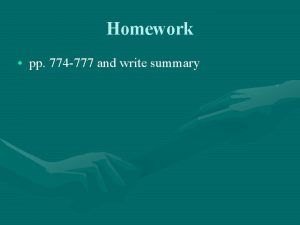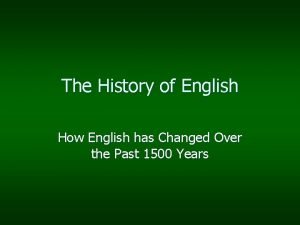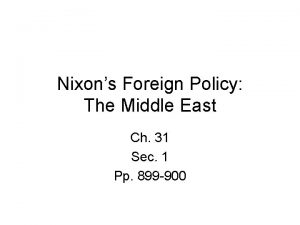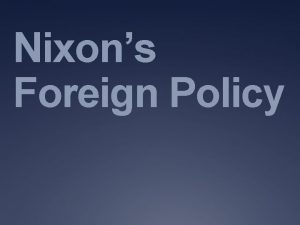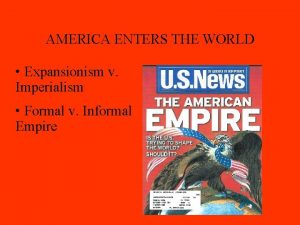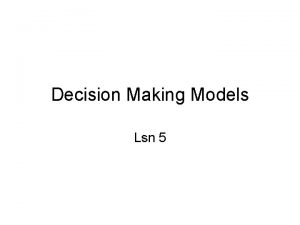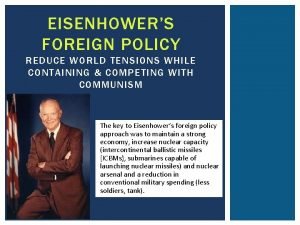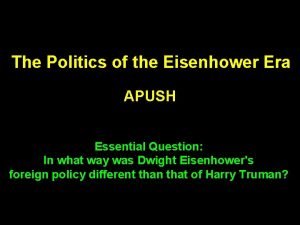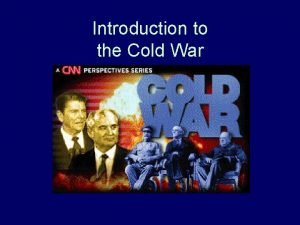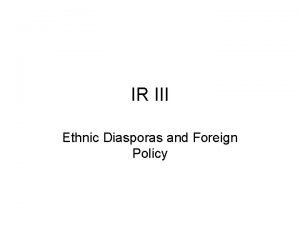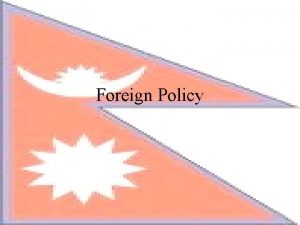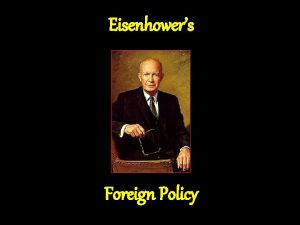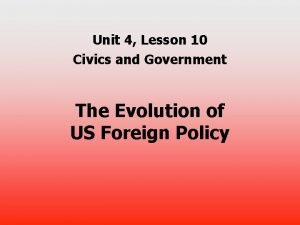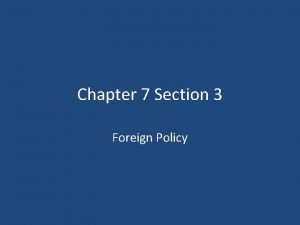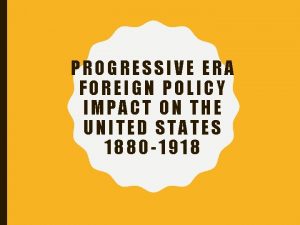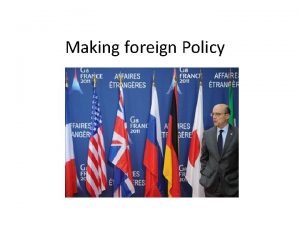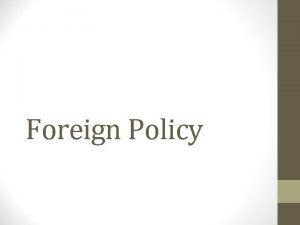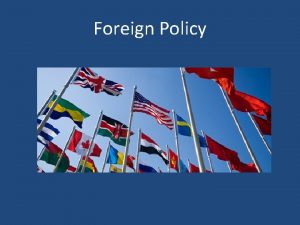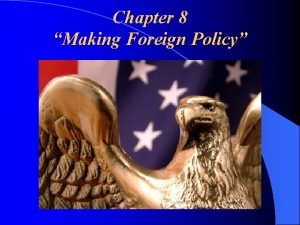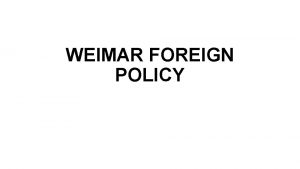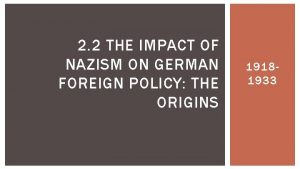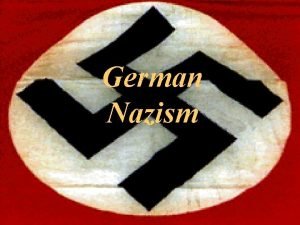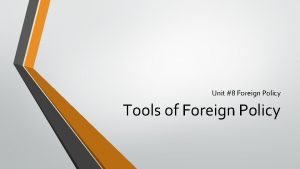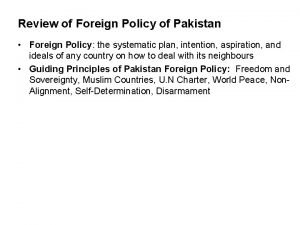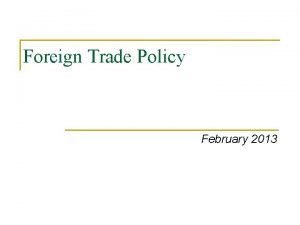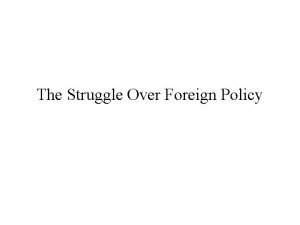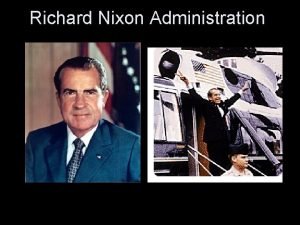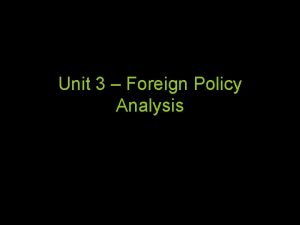Impact of Nazism on German Foreign Policy The
























- Slides: 24

Impact of Nazism on German Foreign Policy: The Origins, 19181933


Nazism �Refers to the policies of the National Socialist Party (Nazi) that took power with Hitler as its leader in 1933 �Roots in opposition to German foreign policy dating from the armistice to the Treaty of Versailles �Bolstered by the Great Depression �Hitler became Chancellor and then consolidated power

Hitler Adolf Hitler born in 1889 in Austria Wanted to be an architect but applications to school were rejected in Vienna Sold scenic paintings to earn a living Became interested in writings of racist authors like Lanz von Liebenfels Began to believe that Germans were superior to other nationalities of the Austro-Hungarian Empire (mainly Slavs) and the rest of the world Hitler resented the wealth of the rich Jewish businessmen of Vienna

The Nazi Party and Hitler also noted that many leading Socialists and Communists were Jews Hitler believed that Darwinism could be applied to human societies Hitler was a German Nationalist and welcomed WWI He enlisted in the German army rather than Austro. Hungarian since he was living in Munich

Impact of the First World War Expected WWI to be short and victorious Failures of the Schlieffen Plan meant a war of attrition Victory had been in signed after the 1918 Treaty of Brest-Litovsk with Russia By November 1918, must of Western and Eastern Europe was under German control

Impact of the First World War Had lost its best troops in the 1918 Ludendorff Offensive, convinced it could not carry on Hoped to preserve the army’s reputation and receive less severe terms by signing the armistice Facing domestic unrest, the Kaiser abdicated in favor a new Weimar Republic Moderately liberal, mostly made of Social Democrats (SPD) German population could not understand the defeat, developed “Stab in the Back” Theory

Impact of the Treaty of Versailles Clemenceau made Germany pay for the damage Article 231 Diktat Reparations De-militarization Territorial/Resource Losses Was either not harsh enough or too severe, left an impotent Germany with little direction

Impact of WWI on Hitler Austrian who had served in the German army Horrified by the armistice, believed the “November Criminals” had subverted the effort at home Sent to investigate the German Workers’ Party in 1919 Group thought to be socialist, actually maintained many nationalist elements By 1920, had become the head of the party Renamed National Socialist German Workers’ Party and created the Sturmabteilung (SA) or Stormtroopers Established the 25 Point Program, a strange mix of catering to workers and rightist elements

Ideology Supremacy of the state and volk Social Darwinism Lebensraum Blood and Soil Pan-Germanism Anti-Democratic Will of the Fuhrer Anti-Feminism Anti-Semitic Anti-Marxism

Conditions of the Weimar Early years characterized by political unrest and economic weakness Hyper-inflation, unemployment Proportional representation meant the failure of coalitions Rise of radical groups on the left and right

Conditions of the Weimar Spartacist Uprising Kapp Putsch Continued attacks from the right on left-wing politicians ▪ 376 assassinations from 1919 -22 German October 1920, leader of the right-wing Freikorps, Wolfgang Kapp, attempted overthrow White Terror 1919, faction of the communist party (KPD) known as the Spartacists launched a rebellion 1923, KPD organized strikes and demonstrations Ruhr Crisis 1923, French and Belgian troops invade the Ruhr valley to enforce reparations payments Response was to print more money to satisfy striking German workers ▪ Devaluing of currency led to increased resentment

Munich Putsch, 1923 Hitler became the leader of the Kampfbund, a collection of militant right-wing groups Inspired by Mussolini’s March on Rome Used 600 SA to attempt a coup in the Bavaria region; disastrous outcome Turned him into a national figure Arrested and imprisoned for only one year Wrote Mein Kampf Vowed only legal methods Distanced himself from any left-wing elements in his movement Party re-launch in 1925, established youth and women’s groups and the Schutzstaffel (SS) in 1926

The Good Years, 1924 -29 Gustav Stresemann instrumental, first as Chancellor and then as Foreign Minister 1924 Dawes Plan invested U. S. capital into German system 1928, industry has exceeded pre-war levels 1925 -29, exports increased 40% 1927 -28, wages became the highest in Europe

The Good Years, 1924 -29 Government spending on health, education and social services increased Unemployment insurance issued to 17 million in 1927 Berlin became a vibrant cultural center No further attempts to seize power 1928 elections saw decreased seats for KPD and Nazis and increase for the SPD 1928 -30, Grand Coalition of SPD, DDP (Democratic Party) DVP (People’s Party) and ZP (Center Party) have over 60% of seats in Reichstag

The Good Years, 1924 -29 French and Belgians withdrew from the Ruhr in 1924 Instrumental in securing borders in the Locarno Pact of 1925 League membership in 1926 Partial Allied withdrawal from the Rhineland in 1928 1929 Young Plan brought further American credit and reduced reparations

Underlying Problems Now heavily reliant on the United States Lagging agriculture Still 2. 8 million unemployed in early 1929 Persistent opposition from Nationalist groups over accepting war guilt Breakup of the Grand Coalition with the Great Depression

Great Depression Wall Street crash in October 1929 meant American credit stopped flowing German businesses bankrupt with massive unemployment Decline of prices and value of exports Forced to cut government spending

Great Depression Return of polarization in politics Street fighting between para-military organizations of the KPD and Nazi Party Devastating failures of chancellors from 1929 -32 Each side promising food and jobs Nazis challenging Stresemann’s internationalism, promoting “Stab in the Back” and “November Criminals” for Treaty of Versailles Hitler’s promises become very attractive to the desperate German people Subsidies to peasants Law and order and return to traditional values to middle class Jobs for unemployed Defense against KPD and revival of Germany as great power


Factors in Hitler’s Rise President General Paul von Hindenburg used emergency powers of Article 48 to make executive decisions Chancellor Bruning asked for his support and called for unscheduled elections in 1930 in response to the crises Nazis went from 12 to 107 seats Hitler even seriously challenged von Hindenburg for President in 1932 ▪ ▪ Hitler impressed army leaders and other right-wing groups who wanted a strong government Hindenburg grew tired of having to support Bruning Replaced by Franz von Paper and then Kurt von Schleicher Both of these men called for Hindenburg to use decree to appoint Hitler as Chancellor in January 1933, hoping he could manage a majority coalition ▪ Thought he could be controlled

Steps to Dictatorship Hitler immediately called for a new election, hoping to gain a Nazi majority Before the vote, the Reichstag was burnt down Hitler claimed it was a communist plot Decree passed suspending freedom of the press and speech Nazis won 43. 9% of the vote

Steps to Dictatorship Hitler prevented the KPD from participating in voting Allowed him to pass the Enabling Act in 1933 ▪ Could now bypass the Reichstag 1933, state parliaments abolished, trade unions banned and opposition parties were forbidden

Steps to Dictatorship July 1934, Hitler fearful of remaining leftist elements in his Nazi Party Night of the Long Knives saw the purge of SA leadership, including Ernst Rohm Carried out by the ring-wing SS August 1934, Hindenburg passed away and Hitler merged the offices of chancellor and president, becoming Fuhrer All German armed forces took a personal oath of loyalty to him
 Nazism vs communism
Nazism vs communism Nazism
Nazism Nazism
Nazism Low german vs high german
Low german vs high german Too foreign for home
Too foreign for home Lesson 5 american foreign policy
Lesson 5 american foreign policy Manchuria apush
Manchuria apush Nixons foreign policy
Nixons foreign policy Foreign policy
Foreign policy Vietnamization definition cold war
Vietnamization definition cold war Foreign policy imperialism
Foreign policy imperialism Rational actor model cuban missile crisis
Rational actor model cuban missile crisis Eisenhowers foreign policy
Eisenhowers foreign policy Open skies apush
Open skies apush Foreign policy of louis philippe
Foreign policy of louis philippe Hitler's foreign policy timeline
Hitler's foreign policy timeline Isolationism antonym
Isolationism antonym Conclusion of cold war
Conclusion of cold war Actors in foreign policy
Actors in foreign policy What is foreign policy analysis
What is foreign policy analysis Andrew johnson foreign policy
Andrew johnson foreign policy Truman foreign policy vs eisenhower
Truman foreign policy vs eisenhower Unit 4 lesson 10 american foreign policy
Unit 4 lesson 10 american foreign policy Foreign policy vocabulary
Foreign policy vocabulary Dollar diplomacy pros
Dollar diplomacy pros
